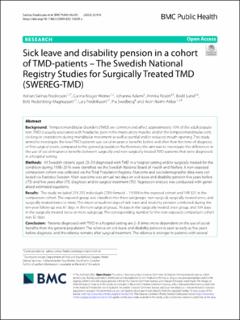| dc.contributor.author | Salinas Fredricson, Adrian | |
| dc.contributor.author | Kruger Weiner, Carina | |
| dc.contributor.author | Adami, Johanna | |
| dc.contributor.author | Rosén, Annika | |
| dc.contributor.author | Lund, Bodil Kristina | |
| dc.contributor.author | Hedenberg Magnusson, Britt | |
| dc.contributor.author | Fredriksson, Lars | |
| dc.contributor.author | Svedberg, Pia | |
| dc.contributor.author | Naimi-Akbar, Aron | |
| dc.date.accessioned | 2022-08-05T09:31:19Z | |
| dc.date.available | 2022-08-05T09:31:19Z | |
| dc.date.created | 2022-05-31T18:45:19Z | |
| dc.date.issued | 2022 | |
| dc.identifier.issn | 1471-2458 | |
| dc.identifier.uri | https://hdl.handle.net/11250/3010307 | |
| dc.description.abstract | Background
Temporomandibular disorders (TMD) are common and affect approximately 10% of the adult population. TMD is usually associated with headache, pain in the masticatory muscles and/or the temporomandibular joint, clicking or crepitations during mandibular movement as well as painful and/or reduced mouth opening. This study aimed to investigate the level TMD-patients use social insurance benefits before and after their first time of diagnosis or first surgical event, compared to the general population. Furthermore, the aim was to investigate the differences in the use of social insurance benefits between surgically and non-surgically treated TMD-patients that were diagnosed in a hospital setting.
Methods
All Swedish citizens aged 23–59 diagnosed with TMD in a hospital setting and/or surgically treated for the condition during 1998–2016 were identified via the Swedish National Board of Health and Welfare. A non-exposed comparison cohort was collected via the Total Population Registry. Outcome and sociodemographic data were collected via Statistics Sweden. Main outcome was annual net days on sick leave and disability pension five years before (-T5) and five years after (T5) diagnosis and/or surgical treatment (T0). Regression analysis was conducted with generalized estimated equations.
Results
The study included 219 255 individuals (73% female) – 19 934 in the exposed cohort and 199 321 in the comparison cohort. The exposed group was classified into three subgroups: non-surgical, surgically treated once, and surgically treated twice or more. The mean annual net days of sick leave and disability pension combined during the ten-year follow-up was 61 days in the non-surgical group, 76 days in the surgically treated once group, and 104 days in the surgically treated twice or more subgroup. The corresponding number for the non-exposed comparison cohort was 32 days.
Conclusion
Patients diagnosed with TMD in a hospital setting are 2–3 times more dependent on the use of social benefits than the general population. The reliance on sick leave and disability pension is seen as early as five years before diagnosis, and the reliance remains after surgical treatment. The reliance is stronger in patients with several surgical interventions. These findings indicate that patients diagnosed with TMD constitute a patient group with a high burden of health issues causing long-term dependence on social security benefits. | en_US |
| dc.language.iso | eng | en_US |
| dc.publisher | BioMed Central | en_US |
| dc.rights | Navngivelse 4.0 Internasjonal | * |
| dc.rights.uri | http://creativecommons.org/licenses/by/4.0/deed.no | * |
| dc.title | Sick-leave and disability pension among TMD patients in a hospital setting – A registry-based cohort study | en_US |
| dc.type | Journal article | en_US |
| dc.type | Peer reviewed | en_US |
| dc.description.version | publishedVersion | en_US |
| dc.rights.holder | Copyright 2022 The Author(s) | en_US |
| cristin.ispublished | true | |
| cristin.fulltext | original | |
| cristin.qualitycode | 1 | |
| dc.identifier.doi | 10.1186/s12889-022-13329-z | |
| dc.identifier.cristin | 2028594 | |
| dc.source.journal | BMC Public Health | en_US |
| dc.source.pagenumber | 916 | en_US |
| dc.identifier.citation | BMC Public Health. 2022, 22, 916. | en_US |
| dc.source.volume | 22 | en_US |

